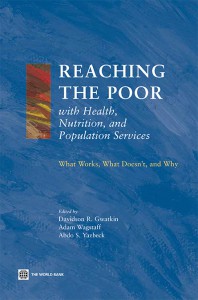Peru: is identifying the poor the main problem in reaching them with nutrional programs
Reaching the poor with health, nutrition, and population services: what works, what doesn' t, and why
| Año | : | 2005 |
|---|---|---|
| Autor/es | : | Martín Valdivia |
| Área/s | : | Salud y nutrición |
[2005] VALDIVIA, Martín. «Peru: is identifying the poor the main problem in reaching them with nutrional programs». En: GWATKIN, Davidson R.; WAGSTAFF, Adam; YASBECK, Abdo S. Reaching the poor with health, nutrition, and population services: what works, what doesn’ t, and why. Washington, D.C.: World Bank. p. 307-334.
In this chapter I analyze the targeting performance of a subset of targeted public food programs in Peru on the basis of information from the Living Standards Measurement Surveys (LSMSs). The programs are Vaso de Leche, the school breakfast program, and several small early childhood nutritional programs with similar objectives and procedures, aggregated under the category ECHINP. Unlike most previous studies, this one focuses on individual data on who benefits from programs, which allows checking not only the extent to which transfers reach poor families but also whether transfers are indeed received by the intended age groups. In addition, I follow two interesting methodological lines that provide important insights for the evaluation of the targeting performance of the programs. One explores the sensitivity of estimated targeting errors to changes in the poverty line; the second analyzes the extent to which the targeting performance of different programs changes with their size and timing. Unlike the case in previousstudies, the marginal analysis presented here for the school breakfast and Vaso de Leche programs compares information for two years (1997 and 2000) so that individual data can be used instead of regional averages.






